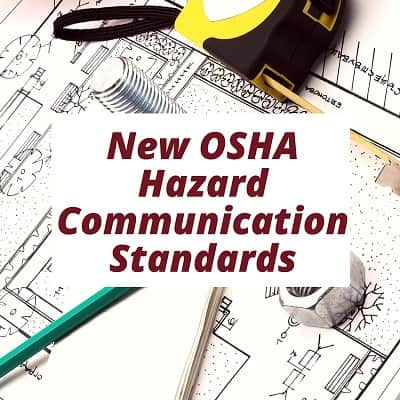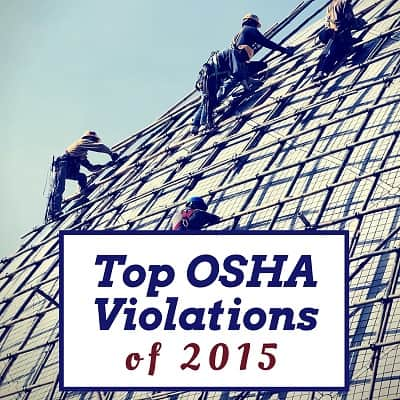New Hazard Communication Standard Updates

The OSHA Hazard Communication Standard (HCS) changes from time to time. To better communicate the physical and health hazards of various compounds, OSHA occasionally makes significant updates to the rules governing storage, labeling and training required for dangerous chemicals.
The administration launched a significant overhaul to the standard in 2012, and additional changes have been proposed since then. Learn more about previous HCS versions and updates to come.
Previous Versions
The rules governing hazard communication, or HAZCOM, are found in 29 CFR 1910.1200. The full document and its appendices now contain more than 200 pages of definitions, rules, tables and charts. But it didn't start that way.
HCS Origins
The OSHA HCS was first finalized in 1983. The administration sought to create a single system allowing employers and employees to understand the hazards posed by chemical compounds found in the workplace. The general mandate of the original standard remains unchanged to this day.
This system protects employees who may be exposed to hazardous chemicals. Those who manufacture or import chemicals must assess their hazards, as well as create labels and Safety Data Sheets (SDSs) that inform their customers of the potential dangers.
Workplaces that contain hazardous chemicals must display labels clearly and supply the SDS to employees who may come in contact with them. Employers must also train workers on the proper handling of these substances.
The 2012 Update
OSHA isn't the only organization with an interest in hazardous chemical communication regulations. The United Nations created the Globally Harmonized System of Classification and Labeling of Chemicals (GHS) to minimize confusion between different systems of chemical documentation.
In 2012, the HCS changed to incorporate the standards of the GHS. The overhaul of the American HAZCOM rules focused on three areas:
Labeling: All labels now contain four elements consistent with international requirements. All hazardous chemicals must include a pictogram depicting the hazard, signal words that specify the level of severity of the danger, an assignment of class and category, plus a precautionary statement that states how the chemical should be handled to reduce the risk of injury.
Safety Data Sheets: Each SDS must follow a standardized 16-section informational format.
Classification: The definitions, classes and categories of hazards posed by each chemical now follow GHS standards.
This review was a major step toward international chemical safety cooperation. The 2012 HAZCOM standard update was based on revision three of the GHS. However, like OSHA's HCS, the U.N. GHS is revised to better protect employers, workers and more.
The Globally Harmonized System is improved and clarified every two years. Eventually, the two standards drifted apart. It was time for a change.
Amendments to the 2021 OSHA Hazard Communication Standard
The administration proposed a rulemaking process to amend the system again in 2021. The goals of the new Hazard Communication Standard are to address issues that emerged as a result of the 2012 rules and keep up with major industry changes.
Changing legal requirements is a long process, however. The final rule was sent to the Office of Management and Budget on October 11, 2023. The publication date is expected at some point in early 2024.
GHS Harmonization
The 2021 update brings 29 CFR 1910.1200 back into alignment with GHS revision seven. The most recent standard clarifies or alters several definitions and includes a new hazard class and several new categories.
Desensitized explosives make up the newest class. This category includes any explosive chemical that must be wetted, diluted or suspended in liquid to reduce explosive properties.
Pyrophoric gases and unstable gases are now categorized under the flammable gases class. This change prevents the broad overclassification of flammable gases. Labels and SDSs are now more specific.
Aerosol classification is also more detailed. In addition to splitting the term into three categories, labeling pictogram changes further differentiate aerosols from gases under pressure.
Finally, the SDS format will change slightly. Sections 9 and 11 of the Safety Data Sheet are the only portions affected by the GHS harmonization.
Other Changes
However, sections 2, 3 and 8 will be clarified to account for confusion following the 2012 HCS implementation. These changes clarify trade secret information, how chemical information is presented and more.
Additionally, the 2021 update makes it easier for the administration to coordinate its efforts with other regulatory bodies like the U.S. Department of Transportation and the U.S. Environmental Protection Agency. Overall streamlining will further reduce friction with major trading partners and international groups.
Implementation
Once the revised rule is published, the administration will establish a compliance timetable. The date or dates by which employers must comply with new rules may be months or even years after the publication date.
Complying with revisions requires multiple changes across many organizations that make, ship or use the chemicals defined in the document. That includes, by federal estimates, more than 115,000 firms, 152,000 establishments and 1.5 million employees.
Many companies choose to adopt revised standards immediately instead of waiting for the final compliance cutoff. This gives manufacturers, importers and other firms ample time to change documentation, revise HAZCOM plans and train staff on provisions.
Hazard Communication Training
In addition to OSHA-authorized Outreach training, we offer a one-hour Hazard Communication Update course. The program will introduce you to the Globally Harmonized System, the anatomy of a Safety Data Sheet, written communication plans and other key concepts for preventing hazardous chemical exposure.



